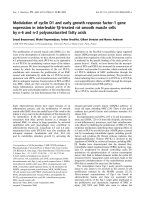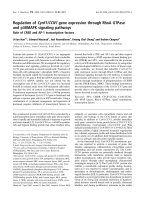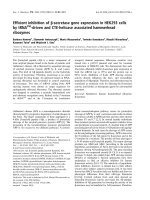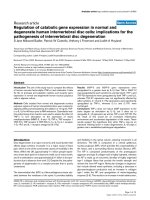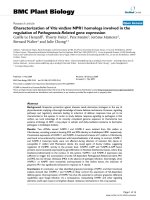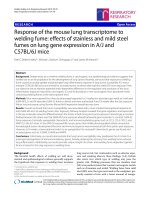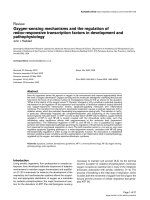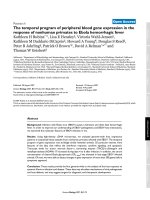Ontogeny and hormonal regulation of alpha amylase gene expression in seabass larvae, lates calcarifer
Bạn đang xem bản rút gọn của tài liệu. Xem và tải ngay bản đầy đủ của tài liệu tại đây (1.21 MB, 195 trang )
ONTOGENY AND HORMONAL REGULATION OF α-
AMYLASE GENE EXPRESSION IN SEABASS LARVAE,
LATES CALCARIFER
BY
MA PEISONG (MASTER OF ENGINEERING)
A THESIS SUBMITTED FOR THE DEGREE OF
PHILOSOPHY DOCTOR
DEPARTMENT OF BIOLOGICAL SCIENCES
NATIONAL UNIVERSITY OF SINGAPORE
2003
i
ACKNOWLEDGEMENT
I would like to thank my supervisor Professor Lam Toong Jin for his guidance,
advice, encouragement and help throughout my study. I wish to express my special
thanks to Dr. Chan Woon Khiong, who has given me many enlightening suggestions,
criticisms and incessant push in my study. I am grateful for the valuable discussions
with Associate professor Gong Zhiyuan, Associate professor Hong Yunhan, Dr. Konda
P. Reddy. I would like to also express my thanks to Associate professor Tan Cheong
Huat, Dr. Sivaloganathan, B. and Dr. Juan Walford for their help during the course of
my study.
I would like to express my thanks to Ms. Siok Hwee, Ms. A. Sharmila, Mr. Seoh
Kah Huat, Robin, Lim Ming Huat, members of my lab, for their help during my study.
I am thankful for the patient explanation and thoughtful help from Mr. Tan Jee Hian,
Allan, Ms. Gao Wei, Ms. Ben Jin, Ms. Xia Jun, Ms, Tong Yan and Dr. Wan Hai Yan. I
am grateful to San Lay Mariculture Pte. Ltd., Singapore, for providing the seabass eggs
used in the present study.
Special thanks to my wife, Kong Hong, for her encouragement, support and
love. Without her unselfish sacrifice, I could not have finished my project.
Finally, I would like to thank the Department of Biological Sciences and the
National University of Singapore for giving me the opportunity and financial support
for this study.
ii
CONTENTS
Acknowledgement Page numbers
Contents
List of Figures
List of Tables
List of Abbreviations
Abstract
Chapter One General Introduction 1
1.1 Ontogeny of the gastrointestinal tract and digestive enzymes of marine
fish larvae 2
1.1.1 Development of gastrointestinal tract 2
1.1.2 The onset of digestive enzymes 6
1.1.3 Amylase 8
1.2 Hormones in fish 9
1.2.1 Functions for Cortisol and T
3
in fish 10
1.2.1.1 Cortisol 11
1.2.1.2 Thyroid hormones 12
1.2.1.3 Interaction of Cortisol and Thyroid hormone in larval development 12
1.2.2 Molecular mechanisms of cortisol and thyroid hormones 13
1.2.2.1 Mechanism of action of cortisol 14
1.2.2.2 Mechanism of action of Thyroid hormones 18
1.3 Seabass (Lates Calcarifer) as a model for endocrinology research
in tropical marine fish 20
iii
1.4 Stress response in fish
21
1.5 Objectives of the project 22
Chapter Two General Materials and Methods 24
2.1Animals 24
2.1.1 Rearing of larvae 24
2.1.2 Rotifer Culture 24
2.1.3 Sampling of larvae 25
2.2 RNA extraction and analysis 25
2.2.1 Total RNA extraction 25
2.2.2 Poly A
+
mRNA isolation 26
2.2.3 Analysis RNA by agarose/formaldehyde gel electrophoresis 26
2.3 Polymerase chain reaction (PCR) 26
2.4 DNA preparation 27
2.4.1 Plasmid DNA miniprep 27
2.4.2 DNA Fragment recovery from agarose gel 28
2.5 Ligation 28
2.6 Restriction enzyme digestion 29
2.7 Transformation 29
2.7.1 Preparation of competent E.Coli DH5α cells 30
2.7.2 Transformation 30
2.8 DNA sequencing 31
2.8.1 Cycle sequencing 31
2.8.2 Sequencing gel electrophoresis 31
2.9. Real time PCR assay 32
iv
2.9.1 The principle of the Real time PCR (LightCycler, Roche) 32
2.9.2 Construction of the standard curve for seabass amylase 33
2.9.3 Quantification by real time PCR 34
Chapter Three Ontogeny of α-Amylase Gene in Seabass Larvae 36
3.1 Introduction 36
3.2 Materials and Methods 38
3.2.1 Amylase assay 38
3.2.2 RT-PCR amplification 39
3.2.3 Genomic PCR amplification 40
3.2.4 Cloning and sequence analysis 41
3.2.5 Cloning of full-length α-amylase gene 41
3.2.6 Southern blot analysis 43
3.2.6.1 Seabass genomic DNA extraction and enzyme digestion 43
3.2.6.2 DNA Gel Electrophoresis and blotting 43
3.2.6.3 Probe labeling 43
3.2.6.4 Hybridization 44
3.2.6.5 Posthybridization washes and immunological detection 44
3.2.6.6 Stripping and reprobing 44
3.3 Result 45
3.3.1 Amylase enzymatic activity during larval development 45
3.3.2. Cloning of a 295 bp fragment of seabass
Glyceraldehyde-3-phosphate Dehydrogenase (GAPDH) gene 46
3.3.3 Cloning of a 318-bp fragment of seabass α-Amylase cDNA 48
3.3.4 Quantification of mRNA using Real Time PCR 48
3.3.4.1 Real time PCR 48
v
3.3.4.2 Quantification 51
3.3.5 5’- and 3’- rapid amplification of cDNA ends of seabass α-amylase gene 54
3.3.6 Seabass α-amylase protein 57
3.3.7 Southern bolt analysis 62
3.4. Discussion 63
3.4.1 Ontogeny of seabass α-amylase gene 63
3.4.2 Seabass α-amylase gene 67
Chapter Four Characterization of the Seabass α-Amylase Promoter 76
4.1 introduction 76
4.2 Materials and Methods 78
4.2.1 Gennomic DNA islation 78
4.2.2 Promoter isolation 78
4.2.3 Construction of reporter plasmids 81
4.2.3.1 Vector preparation and ligation 81
4.2.3.2 Construction of pGL3-2291 81
4.2.3.3. Construction of pEGFP-2291 82
4.2.3.4 Generation amylase promoter deletion constructs 83
4.2.4 Site-directed mutagensis 85
4.2.5 Transient transfection of cells 87
4.2.5.1 Maintenance of cells 87
4.2.5.1.1 Maintenance of Medaka embryonic stem cells,
Medaka testis cells, Hela cells and CHO cells 87
4.2.5.1.2 Maintenance of AR42J cell line 88
4.2.5.2 Preparation of fetal bovine serum stripped of cortisol 89
vi
4.2.5.3 Preparation of Dexthamethasone 89
4.2.5.4 Transfection 89
4.2.5.4.1 Transient Transfection in AR42J cells 89
4.2.5.4 Transient Transfection in HeLa, CHO,
Medaka embryonic stem cells and Medaka testis cells 91
4.2.6 Dual-luciferase reporter assay 92
4.2.7 Electrophoretic mobility shift assay (EMSA) 92
4.2.7.1 Extraction of nuclear protein from AR42J cells 93
4.2.7.2 γ-
32
p ATP labeling of the oligonucleotides 94
4.2.7.3 DNA-protein interaction 94
4.2.7.4 Binding specificity of glucocorticoid receptor
to glucocorticoid receptor element 96
4.2.7.5 Autoradiography of the PAGE gel 96
4.2.8 Statistical Analysis 96
4.3 Result 97
4.3.1. Isolation and characterization of seabass α-amylase promoter 97
4.3.1.1 Isolation of seabass amylase promoter 97
4.3.1.2 Characterization of seabass α-amylase promoter 97
4.3.2. Tissue-specific expression of seabass pancreatic α-amylase promoter 101
4.3.3 Dexamethasone induction of amylase promoter activity in AR42J cells 102
4.3.4 A palindromic glucocorticoid response element is
essential for hormone induction
105
4.3.5 Confirmation of GRE by EMSA 108
4.3.6 Regulatory elements of seabass amylase promoter 110
4.3.6.1 Putative Pancreas transcription factor (PTF) binding site in
seabass amylase promoter 110
4.3.6.2 Hepatocyte nuclear factor 3 (HNF-3) required
for expression of amylase promoter 112
vii
4.4 Discussion 113
4.4.1 Tissue specificity of amylase promoter 113
4.4.2 Funtional charateriztion of the seabass α-amylase promoter 115
4.4.2.1 Identification of a functional glucocorticoid response element
in the amylase promoter 115
4.4.2.2 Cis-elements for exocrine pancreas-specific expression 118
4.4.3 Evolution of α-amylase gene 124
Chapter Five Hormone Influence on Amylase Gene Expression 129
5.1 Introduction 129
5.2 Material and Methods 131
5.2.1 Preparation of fetal bovine serum 131
5.2.2 Hormone treatment of seabass larvae 132
5.2.3 Diet restriction 132
5.2.4 Food deprivation 133
5.2.5. Enzymatic determination of glycogen 133
5.2.6 Statistical analyses 134
5.3 Results 134
5.3.1 Quantification of mRNA level of trypsinogen using Real-time PCR 134
5.3.2 Induction of amylase promoter by Cortisol and Triiodothyronine (T
3
) 135
5.3.3 Treatment of seabass larvae with cortisol and T
3
138
5.3.4 Larvae fed different Artemia rations and their effect on 139
amylase gene expression
5.3.5 Amylase gene response to food deprivation in seabass larvae 141
5.3.6. Glycogen levels in fasting (food-deprived) larvae 143
viii
5.4 Discussion 144
5.4.1 Onset of digestive enzymes 144
5.4.2 Hormonal manipulation of seabass amylase gene expression 146
5.4.3 Effects of food rationing and deprivation on amylase gene expression 148
Chapter 6 Concluding Remarks 152
6.1 Conclusions 152
6.2 Suggestions for future work 154
Reference 156
ix
LIST OF FIGURES
Fig.1.1 The aquaculture life cycle for marine fish. 2
Fig.1.2 Development of the diffuse pancreas in Japanese flounder. 5
Fig.1.3 Biosynthesis of cortisol in teleost fishes. 11
Fig.1.4 Classical model of glucocorticoid action. 15
Fig.1.5 Dimerisation of the glucocorticoid receptor occurs on binding to DNA.
Interactions between the two monomers are through the dimerization loop. 16
Fig. 1.6 Model of gene repression by unliganded TR and activation
by liganded TR. 19
Fig.2 The principle of the Real time PCR. 33
Fig 3.1 Specific activity of amylase during larval development in seabass 45
(Lates calcarifer).
Fig. 3.2
(A) The sequence of seabass GADPH gene. 46
(B)Aligment of amino acid sequences of GADPH from seabass (AF322254),
rainbow trout (AB 066373), Mouse (XM_14423), and
Human (CAA37794). Residues conserved in 50% of the sequences are shaded.
(C) Agarose gel electrophoresis of RT-PCR product of GADPH
in seabass larvae. 47
Fig. 3.3
(A) Alignment of amino acid sequences of amylase from
seabass, winter flounder, rat and chicken.
(B)Agarose gel electrophoresis of RT-PCR product of amylase
in seabass larvae. 49
Fig. 3.4 Titration of MgCl
2
concentrations using
LightCycler instrument.
(A) Amplification curves.
(B) The melting curve analysis. 50
Fig. 3.5 Real time PCR of standard curves using a cloned plasmid
DNA as template.
(A), Amplification from zero to 10 million copies of plasmid DNA.
(B) Calibration curves obtained by correlating crossing point and
plasmid copy number from amplification A. 52
Fig 3.6 Real time PCR analysis of α-amylase mRNA expression during
seabass larval development. 53
Fig. 3.7 5’- and 3’- rapid amplification of cDNA ends of seabass α-amylase gene.
x
(A) 5’ RACE. (B) 3’ RACE. 54
Fig. 3.8 Overview of RT-PCR amplification of seabass
α-amylase 318 bp cDNA (A) and the SMART RACE procedure (B). 55
Fig. 3.9 The full length sequence of seabass α-amylase gene. 56
Fig. 3.10 Alignment of seabass α-amylase amino acid sequence with
chicken, mouse and human pancreatic (Amy2A) amylases. 58
Fig. 3.11 Exon/Intron organization of the seabass amylase gene. 61
Fig. 3.12 Autoradiograms of genomic DNA hybridized with
probe 1, 2 and 3 respectively. 62
Fig. 3.13 Phylogenetic tree of selected α-amylases using PAUP
(phylogenic analysis using parsimony). 68
Fig. 3.14 Genomic organization of human Amy2, Amy1,
chicken, Fugu and seabass amylase. 70
Fig. 3.15
(A) Schematic diagram showing the relative position of exons
and introns of human and seabass α-amylase genomic organizations.
(B) Alignment with seabass exon VI and human α-amylase exon
VI and VII to show the lost intron position in seabass. 71
Fig 3.16 Human Pancreatic -Amylase from Pichia pastoris,
Glycosylated Protein. 73
Fig 3.17 Sequence alignment of human pancreatic
amylase 2A, 2B and salivary amylase. 74
Fig.4.1 Flow chart of the GenomeWalker protocol (Clontech). 80
Fig.4.2 pGL3-Basic Vector circle map (Promega).
Seabass amylase promoter was inserted Mlu1sites. 82
Fig.4.3 Diagram of chimeric construct pEGFP-2291.
The 2,291 bp amylase promoter was inserted into pEGFP-1 vector (Clontech). 83
Fig 4.4 Schematic representation of the structure of the 2,239 bp
amylase promoter and its sequentially deleted fragments inserted
upstream from coding region in the pGL3-Basic vector (Promega). 84
Fig.4.5 Morphology of AR42J cells from a 7 days culture. 89
Fig. 4.6 Results of primary and secondary Genome Walker PCR. 98
xi
Fig. 4.7 The 2,307 bp sequence upstream of the ATG start codon of
seabass amylase gene. 100
Fig. 4.8 Organization of seabass α-amylase promoter. 103
Fig.4.9 Experiment comparing seabass α-amylase construct
(pGL3-2291) activities expressed in AR42J, Hela, CHO,
Medaka ES and TES cells. 103
Fig 4.10 Amylase promoter luciferase activity in
(A) increasing time course and
(B) increasing dexamethasone concentrations (0 to 10
-5
M). 104
Fig. 4.11
(A) 5’ deletion PCR products from -1416 to -149 are shown from lane 1 to lane 7.
(B). Luciferase assays of promoter activity with deletion mutants transfected into
AR42J cells. 106
(C). Luciferase assays of promoter activity with deletion mutants
transfected into AR42J cells. 107
Fig. 4.12 Effect of site-directed mutagenesis in GRE site on luciferase activity. 108
Fig. 4.13 Electrophoretic mobility shift assays on the glucocorticoid
receptor binding to amylase promoter. 109
Fig. 4.14 Electrophoretic mobility shift assays on the pancreas transcription factor
(PTF) and hepatocyte factor 3 (HNF-3) binding to amylase promoter. 111
Fig. 4.15 Effect of site-directed mutagenesis in PTF and HNF sites. 113
Fig. 4.16 Model for regulation of HNF-3β expression by cell-restricted
transcription factors in liver and pancreas. 121
Fig. 4.17 Molecular pathway of cell fate choice in early pancreas development. 125
Fig. 4.18 Relationships among the 5’ regions of the human, mouse
and seabass amylase genes. 128
Fig. 5.1 Real-time PCR analysis of α-amylase and trypsinogen mRNA 136
expression during seabass larval development.
Fig 5.2 The sequence of trypsinogen gene of seabass 137
Fig. 5.3 Amylase promoter luciferase activity in increasing T
3
138
concentrations (0 to 10
-5
M).
Fig. 5.4 Effects of cortisol and T
3
on seabass amylase 140
gene expression at 3, 5, 7 dph.
xii
Fig. 5.5 Amylase gene expression in seabass larvae in four dietary groups. 141
Fig. 5.6 Fasting effect on amylase gene expression. 142
Fig. 5.7 Seabass whole body glycogen content in fed and unfed
seabass larvae during early larval development. 143
Fig. 6.1 Summary of the organization of cis-element of
seabass α-amylase promoter. 153
xiii
LIST OF TABLES
Table 3.1 Oligonucleotide primers used in RT-PCR Amplification ,
Lightcycler PCR and Genomic PCR 40
Table 4.1 List of Primers used in constructing sequential promoter deletion. 85
Table 4.2 List of plasmid constructs used in this study. 86
Table 4.3 Probes used in EMSA 95
Table 4.4 Conserved PTF elements (Box A and B) associated with amylase gene. 119
Table 5.1 Detection of amylase and trypsin enzyme activities in
five marine fish larval species. 145
xiv
ABBREVIATIONS
aa amino acid
APS ammonium persulphate
BCIP 5-bromo-4-chloro-3-indolyl phosphate
bHLH basic helix-loop-helix
bp base-pairs (= pairs of nucleotides)
BSA bovine serum albumin
DEPC diethyl pyrocarbonate
DIG digoxygenin
dph days post hatching
DNase deoxyribonuclease
EDTA ethylene diaminetetraacetic acid
EGFP enhanced green fluorescent protein
EMSA Electrophoretic mobility shift assay
FBS fetal bovine serum
GRE glucocorticoid response element
HEPES N-2-hydroxyethylpiperazine-N’-2-ethane sulfonic acid
HNF hepatocyte nuclear factor
IPTG isopropyl-β-D-galactopyranoside
ISH in situ hybridization
LB medium Luria-Bertani medium
MMLV moloney murine leukemia virus
mRNA messenger RNA
PAGE Poly Acrylamide Gel Electrophoresis
PBS phosphate-buttered saline
PCR polymerase chain reaction
PEPCK phosphenolpyruvate carboxykinase
PTF-1 pancreatic transcription factor 1
RACE rapid amplification of cDNA ends
RNase riboxynuclease
RT-PCR reverse transcription polymerase chain reaction
SDS sodium dodecyl sulfate
SSC sodium chloride-trisodium citrate solution
TAE Tris acetate-EDTA
TBE Tris borate-EDTA
TE Tris-EDTA
xv
ABSTRACT
To understand the development of digestive functions in marine fish larvae, the
ontogeny and regulation of gene expression of α-amylase were studied in seabass
(Lates calcarifer) larvae. The enzymatic activities of α-amylase and their
corresponding mRNA levels were studied from hatching until 27 days post-hatching
(dph). An increasing activity of amylase enzyme was recorded until 5 dph, and
thereafter the activity gradually decreased and reached a steady but low level by 12
dph. To confirm this, we also studied the ontogeny of amylase gene expression. For
this purpose, we cloned and sequenced a 318-bp fragment of α-amylase cDNA. Based
on this sequence, a real-time reverse transcription polymerase chain reaction (RT-
PCR) technique was developed to monitor the changes in the mRNA levels in the
larvae. A correlation between enzymatic activity and mRNA level of α-amylase was
demonstrated during the early development of seabass larvae. This suggests that the
changes in α-amylase are controlled at the transcriptional level at least during the early
larval development of seabass. In vivo thyroid hormone and cortisol treatment of
seabass larvae upregulated the gene expression, suggesting the possibility of endocrine
control of transcription. This led us to focus our subsequent studies on the molecular
mechanisms of amylase gene expression and transcriptional regulation.
The full length cDNA was cloned and characterized. Sequence analysis showed
that the coding region and the exon/intron boundaries are highly homologous to those
of mammalian amylases. However, the promoter regions are distinctly divergent. To
investigate the seabass amylase promoter, a series of deletion mutants were generated
and fused to the luciferase reporter gene, followed by studies of their functional
activity in the rat AR42J cell line. Besides identifying several potential regulatory
elements based on those that had previously been identified in the human and mouse
xvi
pancreatic amylase promoter, we have identified a glucocorticoid response element
(GRE). While the human and mouse pancreatic amylase promoters are highly
homologous between nucleotide -160 and transcription start site, which include GRE,
the 5’ promoter deletion analysis revealed that the GRE of the seabass amylase
promoter was located far upstream, -947 to -776 bp, of the promoter. Site-directed
mutagenesis of the putative GRE, and electrophoretic mobility shift assays (EMSA)
confirmed that this region was responsible for induction by dexamethasone. However,
no functional pancreas transcription factor-1 (PTF-1) binding site, which is responsible
for pancreas-specific transcription in higher vertebrates, was identified in the seabass
amylase promoter. Instead a Hepatocyte Nuclear Factor 3 (HNF-3) binding site was
found to modulate the amylase promoter expression.
A functional GRE on the amylase promoter indicates that the in vivo cortisol
(glucocorticoid) stimulation of amylase gene expression was direct via the GRE.
However no TRE (thyroid response element) was found on the amylase gene or its
promoter. This suggests that the in vivo T
3
of amylase gene expression was indirect.
We also looked at the effect of food restriction and deprivation on amylase gene
expression. Food deprivation increased amylase gene expression 5 fold.
Concomitantly, body glycogen level also decreased. The findings are interpreted as a
stress response whereby cortisol secretion was elevated which activated the GR-
transcription system and upregulated amylase gene expression.
1
CHAPTER 1
GENERAL INTRODUCTION
Successful mass rearing of larvae is a basic prerequisite in commercial fish
hatcheries. However, high mortality often occurs in the early larval development,
particularly around the time of first feeding. Marine fish larvae have poorly developed
digestive tracts at hatching (Walford and Lam, 1993). The switch from endogenous (yolk-
based) to exogenous feeding is concomitant with morphological and functional
transformations of the digestive tract. Among tropical marine fish species, this shift occurs
very quickly compared to temperate or cold-water fish species, and develops within a few
days after hatching (Sivaloganathan et al., 1998). The stage during which larvae transit to
exogenous energy sources is a critical period during larval development (Fig. 1.1),
because it affects their survival, growth and development (Gawlicka et al., 2000).
Rearing of marine fish larvae in aquaculture is still dependent on the supply of live food
organisms, such as rotifers and Artemia. However, live feed is costly and so far does not
allow a standardized production protocol and cost effective production output. Therefore,
compound diet substitution for live prey is desirable but so far has met with little success
(Cahu and Zambonino Infante, 2001). More detailed information on the developmental
changes of the gastrointestinal tract and onset of digestive enzymes secretion during the
different larval stages is required in order to fully understand the nutritional physiology of
larval fish for progress in the improvement of marine fish larval survival and in the
development of replacement diet.
2
Fig. 1.1 The aquaculture life cycle for marine fish
1.1 Ontogeny of the gastrointestinal tract and digestive enzymes of marine fish larvae
1.1.1 Development of gastrointestinal tract
The transformation of the digestive system marks the transition from larva to
juvenile. The juvenile has a digestive system similar to that of adults and they can be fed
similar diets, consisting of either trash fish or formulated feed. However, the stomach,
intestine and pancreas are under-developed at hatching and these organs undergo
morphological and functional changes during the development of the larvae.
From an anatomical point of view, the stomach is somewhat developed in adult fish
depending on the species. In the seabass of this study, the stomach has assumed its definite
A
A
Q
Q
U
U
A
A
C
C
U
U
L
L
T
T
U
U
R
R
E
E
C
C
Y
Y
C
C
L
L
E
E
A
A
d
d
u
u
l
l
t
t
Y
Y
o
o
l
l
k
k
-
-
s
s
a
a
c
c
l
l
a
a
r
r
v
v
a
a
F
F
i
i
r
r
s
s
t
t
-
-
f
f
e
e
e
e
d
d
i
i
n
n
g
g
l
l
a
a
r
r
v
v
a
a
M
M
e
e
t
t
a
a
m
m
o
o
r
r
p
p
h
h
o
o
s
s
e
e
d
d
l
l
a
a
r
r
v
v
a
a
e
e
E
E
g
g
g
g
C
C
R
R
I
I
T
T
I
I
C
C
A
A
L
L
PPEERRIIOODD
M
M
a
a
s
s
s
s
m
m
o
o
r
r
t
t
a
a
l
l
i
i
t
t
y
y
3
shape on day 15; the cardiac portion of the stomach joins the pyloric portion at a sharp
angle and this gives the characteristic pointed shape to the stomach. As the individuals
grow, the stomach becomes larger and the ceca continue to develop. However, the form of
the stomach and ceca remain unchanged in the juvenile from day 80 (Walford and Lam,
1993).
On the third day post hatch, the intestinal epithelium of seabass larvae has a regular
surface. Thickening and undulations in intestinal epithelium has been observed on day 7.
At around day 14, the intestinal epithelium has numerous microvilli at the luminal surface
forming the brush border (Walford and Lam, 1993; Zambonino Infante and Cahu, 1994 b).
Pancreas tissue are present only in vertebrates including fish. Thus, fish can be used
to investigate the phylogenic development of the pancreas. In most teleost species, the
pancreas develops prior to the differentiation of the stomach and gastric gland (Govoni,
1980; O’Connell, 1981). With the exception of a small number of species, teleosts have a
diffused pancreas (Harder, 1975). The morphology diverges greatly among bony,
cartilaginous and agnathan fishes, and the standard pancreatic morphology present in
higher vertebrates cannot be observed in some fishes. The relationship of endocrine and
exocrine pancreatic cells, distribution of islets, presence or absence of principal islet and
distribution of cell types within the islet can be used to compare the divergent morphology
of piscine pancreas (Youson and Al-Mahrouki, 1999). In European seabass
(Dicentrarchus labrax) larvae, the differentiation of exocrine cells and the appearance of
the excretory duct occur at day 3 post hatching (dph), before the mouth opening. The
presence of zymogen granules and of the pancreatic duct (called the duct of Wirsung)
characterizes these events (Beccaria et al., 1991). In the Japanese flounder Paralichthys.
olivaceus, gastric glands do not develop until metamorphosis, so the pancreas is the sole
4
exocrine organ responsible for secreting digestive enzymes during the larval stage (Miwa
et al., 1992). The pancreas development of the flounder is reproduced in Figure 1.2. The
pancreas, which is located at the boundary between the oesophagus and intestine, is a
compact organ at 3 dph. It starts to elongate posteriorly along veins on the intestine at 20
dph. After metamorphosis (45 dph), the pancreas is localized along the veins running
towards the porta hepatis from the stomach, pyloric appendages and intestine. Pancreatic
tissue has also begun to invade the liver along the hepatic portal vein, thereby forming a
diffuse pancreas. Since the gastric glands of the stomach wall are also differentiated at
metamorphosis, it has been suggested that the digestive system of the flounder assumes
the adult form in the early juvenile stage following metamorphosis (Kurokawa and
Suzuki, 1996). Because the digestive system of the flounder becomes equivalent to that of
the adult during the early juvenile stage, this may be one of the reasons why artificial diets
can be utilized by juveniles but not by larvae (Kurokawa and Suzuki, 1996). The increase
in volume of the pancreas and the presence of gastric glands are obvious differences
between larval and adult digestive systems. It was reported that there was no secretion of
pancreatic enzymes by European sea bass larvae (D. labrax) fed an artificial diet even
though the digestive tract was full of food (Beccaria et al., 1991). These results suggest
that the larvae are not dependent on exogenous enzymes for digestion, and not only the
exocrine capacity but also the mechanism of regulation of the pancreas differ between
larvae and adults. If artificial diets are to be developed for larvae, it will be important to
understand the mechanisms by which digestive enzyme secretion is regulated in larval
fish.
5
Fig. 1.2. Development of the diffuse pancreas in Japanese flounder (Paralichthys
olivaceus). The morphology of the pancreas was reconstructed from serial histological
sections and is represented schematically. Shaded areas indicate pancreatic tissue. The
developmental stages PL to I follow the terminology developed by Minami (1982) for
flounder larvae. (a) 3 dph, stage PL. (b) 10dph, stage A. (c) 20 dph, stage D. (d) 30 dph,
stage F. (e) 45 dph (completion of metamorphosis), stage I . bd:bible duct; es:esophagus;
hd: hepatic duct; in: intestine; li: liver; pa: pancreas; ph: porta hepatis; py: pyloric
appendages; re: rectum; st: stomach (Reproduced from Kurokawa, 1996).
6
1.1.2 The onset of digestive enzymes
In recent years, there has been an increasing interest to study the development of
digestive enzymes in marine fish larvae in an attempt to facilitate the choice of the
optimum feeding strategy. The onset of digestive functions, associated with
morphological transformations, follows a sequential chronology in developing fish like
that in developing mammals. Ontogenetic development of digestive enzymes has been
studied in various fish systems using enzymatic assays and immunohistochemical
methodologies (Walford and Lam 1993; Oozeki and Bailey 1995; Moyano et al., 1996;
Baglole et al., 1998; Ribeiro et al., 1999). In European seabass, trypsin activity can be
detected on day 3 post hatching and a sharp increase in trypsin and amylase activities
coincides with the mouth opening (5 dph), and corresponds to the first secreted zymogen
granules (Zambonino Infante and Cahu, 1994 b). Studies on Clupea harengus, D.labrax
and Solea senegalensis suggest that the synthesis process of pancreatic enzymes is not
induced by food ingestion. The specific activities of the main pancreatic enzymes follow a
similar pattern during development. This pattern shows that the pancreatic digestive
capacity of young larvae is very high, related to their weight, and the enzyme synthesis
process is linked to age (Cahu and Zambonino Infante, 2001). Amylolytic and amylase
activities, in general, decrease with fish age. This observation agrees with previous
findings on carbohydrase activities in rainbow trout (Kuz’mina, 1996). In European
seabass (D. labrax), higher amylase mRNA levels are found in young larvae than in older
larvae. The coordinated decrease between amylase enzyme activity and mRNA levels of
amylase suggests a transcriptional regulation of amylase expression during larval
development. Furthermore, the decrease in amylase activity is observed irrespective of the
7
dietary glucide concentration (Peres et al., 1998). This indicates that the decrease in
amylase activity during larval development may be genetically programmed.
Although lipids and proteins have generally been considered to be the major
substrates for energy metabolism in larval early development (Ostrowski and Divakaran
1991; Koven et al., 1992), several studies show that marine fish larvae produce a large
amount of α-amylase enzyme around the time of first feeding (Cahu and Zambonine
Inante, 1994; Oozeki and Bailer, 1995; Martinez et al., 1999). This raises the possibility
that marine fish larvae may utilize carbohydrates during early development to help meet
their energy requirement. Kim and Brown (2000) demonstrated that the ontogeny of
digestive enzymes in the Pacific threadfin (Polydaxtylus sexfilis) follows a pattern in
which amylase is the first to become activated, followed by lipase and protease later in
development. These results indicate that carbohydrate utilization play a significant role in
the earlier phases of development among some marine fish larvae, followed by a shift to
protein and lipid utilization.
Although the data obtained in fish so far show that the digestive enzymes studied
are qualitatively similar to those observed in other vertebrates, some assay factors, as well
as the broad variety of techniques used to determine the different enzymatic activities,
may cause variability in the final data (Hidalgo et al., 1999). These factors are: 1) non-
uniformity in the tissue used for enzymatic activity determinations results in the procedure
sometimes involving the homogenization of attached glands and/or the whole digestive
tract; 2) the nutritional status of the animals used in the experiments is not consistent, as
the animals are killed either after starvation or at different post-feeding times; 3) the
digestive tract is washed before homogenization in some cases, whereas others have used
the tract including its contents for extraction; and 4) enzymes from prey also contribute
8
importantly to digestive capacity in larvae. It has been reported that the trypsin activity
contribution of Artemia could amount to a maximum 5 % of the total assayed activity in
20-day-old seabass larvae (Cahu and Zambonino Infante, 1995), and the calculated
contribution of Artemia amylase activity was more than 50 % of the total amylase activity
measured in the metamorphic Atlantic halibut (Hippoglossus hippoglossus) larvae
(Gawlicka et al., 2000).
Only limited diet-related manipulation of digestive abilities may be possible (Collie
and Ferraris, 1995; Peres et al., 1998), the ontogenetic sequence of digestive system
development appears to be genetically programmed in fishes (Buddington and Diamond,
1989; Gawlicka et al., 2000; Cahu and Zambonino Infante, 2001). Therefore, finer-
resolution and more definitive examination such as that afforded by enzyme gene
expression and regulation using molecular approaches is desirable to clarify some aspects
of larval nutritive physiology and help solve some ontogenetic questions in early fish
larval development.
1.1.3 Amylase
The function of α-amylase is the hydrolysis of α-1,4 glycoside bonds in
carbohydrate, such as starch and glycogen, and amylases occurs widely in nature, being
found in bacteria, plants and animals. In humans, α-amylase is composed of 496 amino
acids in a single polypeptide chain, which is encoded on chromosome I as part of
multigene family (Gumucio et al., 1988). These genes are regulated so that different
isozymes are synthesized in either salivary glands or the pancreas.
